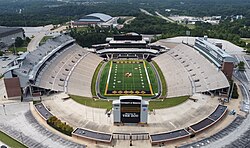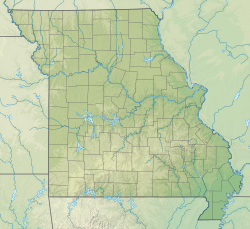"The Zou" | |
 Aerial view of Faurot Field taken in 2021 | |
| Location | 600 East Stadium Boulevard Columbia, Missouri 65201 |
|---|---|
| Coordinates | 38°56′9″N 92°19′59″W / 38.93583°N 92.33306°W |
| Owner | University of Missouri |
| Operator | University of Missouri |
| Capacity | 62,621 (2019–present)[1][2]
Former capacity: |
| Record attendance | 75,298 |
| Surface | Grass (1926–1984, 1995–2002) Omniturf (1985–1994) FieldTurf (2003–2020) AstroTurf (2021–present)[7] |
| Construction | |
| Broke ground | December 9, 1925[8] |
| Opened | October 2, 1926 |
| Renovated | 1978, 2003, 2012 |
| Expanded | 1949–1950, 1961–1965, 1971, 1978, 1996, 2003, 2009, 2014 |
| Construction cost | $525,000[9] ($9.04 million in 2023 dollars[10]) |
| Architect | Jamieson and Spearl (original) Ellerbe Becket (renovation)[11] |
| Tenants | |
| Missouri Tigers football (NCAA) (1926–present) | |
| Website | |
| mutigers.com/memorial-stadium-faurot-field | |
Faurot Field (/fɔːˈroʊ/ faw-ROH, /fəˈroʊ/ fə-ROH[citation needed]) at Memorial Stadium is an outdoor sports stadium in Columbia, Missouri, United States, on the campus of the University of Missouri. It is primarily used for football and serves as the home field for the Missouri Tigers' program. It is the third-largest sports facility by seating capacity in the state of Missouri, behind The Dome at America's Center in St. Louis and Arrowhead Stadium in Kansas City. In 1972, Memorial Stadium's playing surface was named Faurot Field in honor of longtime coach Don Faurot.
During the offseason, soccer goals are set up in the end zones and it is used for intramural matches. Until 2012 it was the site of the annual "Providence Bowl" game between Hickman and Rock Bridge high schools, so named because both schools are located on Providence Road in Columbia, and Faurot is roughly equidistant between the two. This tradition stopped when Missouri joined the Southeastern Conference and conference scheduling made hosting the game more difficult. Faurot Field has also served as the host of Missouri State High School Activities Association (MSHSAA) football championships.
The stadium is an early 20th century horseshoe-shaped stadium, with seating added on in the "open" (south) end zone. The original horseshoe is completed by a grass berm in the curved end, which is used for general admission on game days. The berm is famous for the giant block "M" made of painted white stones located behind the end zone. A paved path encircled the west, north and east sides of the field taking the place of the track, but was removed in 1994.
- ^ Moore, Wilson (March 17, 2021). "MU to allow full Faurot Field capacity for 2021 season". Columbia Missourian. Retrieved March 31, 2023.
- ^ Gillam, Parker (June 9, 2022). "A call to action for Mizzou football fans". Rock M Nation. Retrieved March 31, 2023.
- ^ "2018 SEC Football Media Guide" (PDF). Southeastern Conference. July 12, 2018. p. 105. Retrieved July 25, 2018.
- ^ Modelski, Kevin; Tai, Tim (August 27, 2014). "Public Gets Sneak Peek of Memorial Stadium Renovations". Columbia Missourian. Retrieved August 30, 2014.
- ^ "An Update to Tiger Nation". University of Missouri Department of Intercollegiate Athletics. August 19, 2013. Archived from the original on December 12, 2013. Retrieved August 26, 2013.
- ^ "Mizzou Football Guide 2009" (PDF) (PDF). Mizzou Athletics. 2009. p. 5. Archived from the original (PDF) on March 16, 2013.
- ^ "New turf installed at Faurot Field for Mizzou's 2021 football season". Columbia Daily Tribune. June 23, 2021. Retrieved July 28, 2021.
- ^ "Start New Stadium". Youngstown Vindicator. December 10, 1925.
- ^ "Memorial Tower at Missouri University Is Now Completed". The Nevada Daily Mail. April 24, 1926.
- ^ 1634–1699: McCusker, J. J. (1997). How Much Is That in Real Money? A Historical Price Index for Use as a Deflator of Money Values in the Economy of the United States: Addenda et Corrigenda (PDF). American Antiquarian Society. 1700–1799: McCusker, J. J. (1992). How Much Is That in Real Money? A Historical Price Index for Use as a Deflator of Money Values in the Economy of the United States (PDF). American Antiquarian Society. 1800–present: Federal Reserve Bank of Minneapolis. "Consumer Price Index (estimate) 1800–". Retrieved February 29, 2024.
- ^ "Faurot Field". Ellerbe Becket. Archived from the original on June 18, 2009. Retrieved October 8, 2009.

